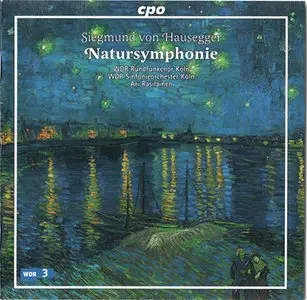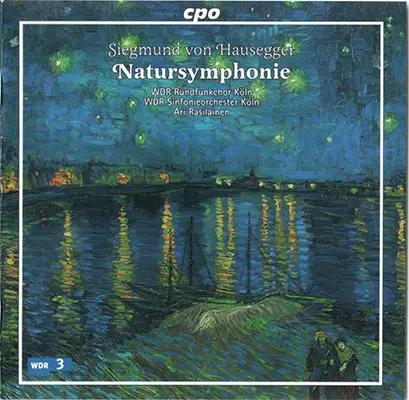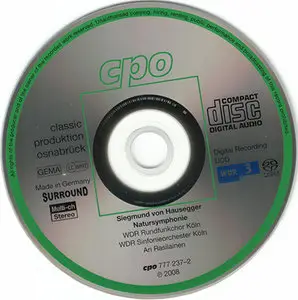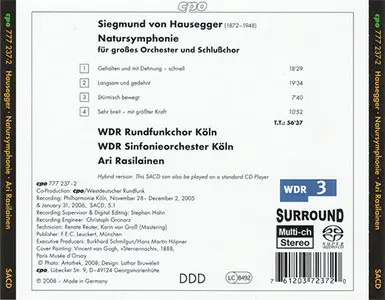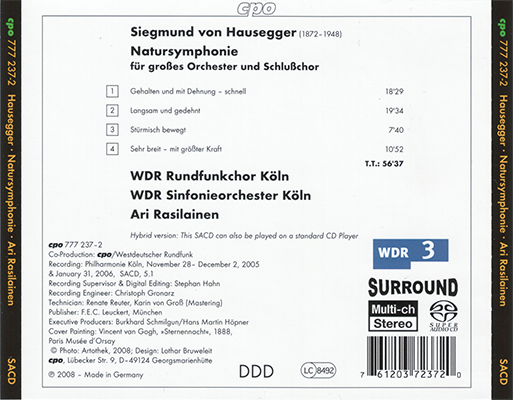Siegmund von Hausegger - Rasilainen - Natursymphonie für großes Orchester und Schlußchor
WDR Rundfunkorchester Köln / WDR Sinfonieorchester Köln / Ari Rasilainen
EAC+LOG+CUE | WV: 248 MB | Full Artwork | 5% Recovery Info
Label/Cat#: CPO # 777237-2 | Country/Year: Germany 2008
Genre: Classical | Style: Early 20th Century
MD5 [X] CUE [X] LOG [X] INFO TEXT [X] ARTWORK [X]
selfrip [] not my rip [X]
Exact Audio Copy V0.99 prebeta 4 from 23. January 2008
EAC extraction logfile from 11. March 2008, 14:14
Ari Rasilainen, WDR SO Koeln / Hausegger: Natursymphonie
Used drive : TSSTcorpCD/DVDW SH-S182M Adapter: 4 ID: 0
Read mode : Secure
Utilize accurate stream : Yes
Defeat audio cache : Yes
Make use of C2 pointers : No
Read offset correction : 6
Overread into Lead-In and Lead-Out : No
Fill up missing offset samples with silence : Yes
Delete leading and trailing silent blocks : No
Null samples used in CRC calculations : Yes
Used interface : Native Win32 interface for Win NT & 2000
Used output format : Internal WAV Routines
Sample format : 44.100 Hz; 16 Bit; Stereo
TOC of the extracted CD
Track | Start | Length | Start sector | End sector
––––––––––––––––––––––––––––-
1 | 0:00.00 | 18:29.00 | 0 | 83174
2 | 18:29.00 | 19:34.49 | 83175 | 171273
3 | 38:03.49 | 7:40.51 | 171274 | 205824
4 | 45:44.25 | 10:52.57 | 205825 | 254781
Range status and errors
Selected range
Filename F:\Release\Ari Rasilainen, WDR SO Koeln - Hausegger Natursymphonie\Ari Rasilainen, WDR SO Koeln - Hausegger Natursymphonie.wav
Peak level 100.0 %
Range quality 100.0 %
Test CRC 7BA26FE0
Copy CRC 7BA26FE0
Copy OK
No errors occurred
AccurateRip summary
Track 1 not present in database
Track 2 not present in database
Track 3 not present in database
Track 4 not present in database
None of the tracks are present in the AccurateRip database
End of status report
EAC extraction logfile from 11. March 2008, 14:14
Ari Rasilainen, WDR SO Koeln / Hausegger: Natursymphonie
Used drive : TSSTcorpCD/DVDW SH-S182M Adapter: 4 ID: 0
Read mode : Secure
Utilize accurate stream : Yes
Defeat audio cache : Yes
Make use of C2 pointers : No
Read offset correction : 6
Overread into Lead-In and Lead-Out : No
Fill up missing offset samples with silence : Yes
Delete leading and trailing silent blocks : No
Null samples used in CRC calculations : Yes
Used interface : Native Win32 interface for Win NT & 2000
Used output format : Internal WAV Routines
Sample format : 44.100 Hz; 16 Bit; Stereo
TOC of the extracted CD
Track | Start | Length | Start sector | End sector
––––––––––––––––––––––––––––-
1 | 0:00.00 | 18:29.00 | 0 | 83174
2 | 18:29.00 | 19:34.49 | 83175 | 171273
3 | 38:03.49 | 7:40.51 | 171274 | 205824
4 | 45:44.25 | 10:52.57 | 205825 | 254781
Range status and errors
Selected range
Filename F:\Release\Ari Rasilainen, WDR SO Koeln - Hausegger Natursymphonie\Ari Rasilainen, WDR SO Koeln - Hausegger Natursymphonie.wav
Peak level 100.0 %
Range quality 100.0 %
Test CRC 7BA26FE0
Copy CRC 7BA26FE0
Copy OK
No errors occurred
AccurateRip summary
Track 1 not present in database
Track 2 not present in database
Track 3 not present in database
Track 4 not present in database
None of the tracks are present in the AccurateRip database
End of status report
auCDtect: CD records authenticity detector, version 0.8.2
Copyright © 2004 Oleg Berngardt. All rights reserved.
Copyright © 2004 Alexander Djourik. All rights reserved.
Detect mode (0..40 with 0 = most accurate): 8 (default)
––––––––––––––––––––––––––––––
[Ari Rasilainen, WDR SO Koeln - Hausegger- Natursymphonie.wav]
Detected average hi-boundary frequency: 2.073228e+004 Hz
Detected average lo-boundary frequency: 1.630644e+004 Hz
Detected average hi-cut frequency: 2.165584e+004 Hz
Detected average lo-cut frequency: 1.442934e+004 Hz
Maximum probablis boundary frequency: 2.189100e+004 Hz
Coefficient of nonlinearity of a phase: 1.872804e-001
First order smothness: 4.100418e-001
Second order smothness: 7.208959e-001
––––––––––––––––––––––––––––––
This track looks like CDDA with probability 100%.
Copyright © 2004 Oleg Berngardt. All rights reserved.
Copyright © 2004 Alexander Djourik. All rights reserved.
Detect mode (0..40 with 0 = most accurate): 8 (default)
––––––––––––––––––––––––––––––
[Ari Rasilainen, WDR SO Koeln - Hausegger- Natursymphonie.wav]
Detected average hi-boundary frequency: 2.073228e+004 Hz
Detected average lo-boundary frequency: 1.630644e+004 Hz
Detected average hi-cut frequency: 2.165584e+004 Hz
Detected average lo-cut frequency: 1.442934e+004 Hz
Maximum probablis boundary frequency: 2.189100e+004 Hz
Coefficient of nonlinearity of a phase: 1.872804e-001
First order smothness: 4.100418e-001
Second order smothness: 7.208959e-001
––––––––––––––––––––––––––––––
This track looks like CDDA with probability 100%.
foobar2000 1.1.14a / Dynamic Range Meter 1.1.1
log date: 2013-02-25 17:37:51
––––––––––––––––––––––––––––––––––––––––
Analyzed: Ari Rasilainen, WDR SO Koeln / Hausegger: Natursymphonie
––––––––––––––––––––––––––––––––––––––––
DR Peak RMS Duration Track
––––––––––––––––––––––––––––––––––––––––
DR12 -1.06 dB -17.74 dB 18:29 01-Gehalten und mit Dehnung - schnell
DR12 -0.67 dB -18.90 dB 19:35 02-Langsam und gedehnt
DR10 -0.64 dB -15.13 dB 7:41 03-Stuermisch bewegt
DR8 0.00 dB -12.71 dB 10:53 04-Sehr breit, mit groesster Kraft
––––––––––––––––––––––––––––––––––––––––
Number of tracks: 4
Official DR value: DR11
Samplerate: 44100 Hz
Channels: 2
Bits per sample: 16
Bitrate: 615 kbps
Codec: WavPack
================================================================================
log date: 2013-02-25 17:37:51
––––––––––––––––––––––––––––––––––––––––
Analyzed: Ari Rasilainen, WDR SO Koeln / Hausegger: Natursymphonie
––––––––––––––––––––––––––––––––––––––––
DR Peak RMS Duration Track
––––––––––––––––––––––––––––––––––––––––
DR12 -1.06 dB -17.74 dB 18:29 01-Gehalten und mit Dehnung - schnell
DR12 -0.67 dB -18.90 dB 19:35 02-Langsam und gedehnt
DR10 -0.64 dB -15.13 dB 7:41 03-Stuermisch bewegt
DR8 0.00 dB -12.71 dB 10:53 04-Sehr breit, mit groesster Kraft
––––––––––––––––––––––––––––––––––––––––
Number of tracks: 4
Official DR value: DR11
Samplerate: 44100 Hz
Channels: 2
Bits per sample: 16
Bitrate: 615 kbps
Codec: WavPack
================================================================================
CD Info:
Siegmund von Hausegger (1872-1948) - Natursymphonie für großes Orchester und Schlußchor
WDR Rundfunkorchester Köln / WDR Sinfonieorchester Köln / Ari Rasilainen
Label: CPO
Catalog#: 777 237-2
Format: Hybrid-SACD, Album
Country: Germany
Released: 2008
Genre: Classical
Style: Modern
Tracklist:
1 - Gehalten und mit Dehnung - schnell 18:29
2 - Langsam und gedehnt 19:35
3 - Stuermisch bewegt 7:41
4 - Sehr breit, mit groesster Kraft 10:53
Siegmund von Hausegger (1872-1948) is usually remembered as the conductor who gave the first performance of the autograph edition of Bruckner’s 9th Symphony with the Munich Philharmonic Orchestra in 1932. His subsequent recording of it is, I believe, still in the catalogue. As a composer, his orchestral output is limited to only five works, the Dionysische Fantasie, Barbarossa, Aufklänge, Wieland der Schmied (once performed by Stokowski in Philadelphia in 1913) and this Natursymphonie of 1911 that requires huge instrumental forces including an organ and large mixed chorus. The work is performed in one continuous span, lasting 56’37” in this recording, but falls into four clearly defined movements.
The opening of the symphony, an arresting series of horn and trumpet calls immediately followed by a ‘De profundis’ passage for solo organ, indicates that this is no conventional work, and so it proves to be. The first movement continues with an exciting allegro that eventually yields a marvellous yearning melody typical of those heard throughout the whole work. The various themes are then developed and build to a massive climax before the music recalls the opening material and gradually dies away into silence. The weighty slow movement that follows continues the dark mood, but its ‘ death lament for nature’ finally blossoms into deeply felt and rhapsodic music of overwhelming intensity and power.
The brief demonic scherzo with its chattering xylophone and thundering timpani also melts into another richly melodic passage before returning to the stormy mood of its wild beginning. A crash on the cymbals signals the entry of the chorus for the final section of the symphony, an imposing setting of the ‘Hymnus ewiger Schöpferkraft’ that increases in magnitude and power, finally reaching a consummation for the full forces most reminiscent of the final five minutes of Mahler’s Resurrection Symphony.
The multi-channel (5.1) recording, a co-production between Westdeutscher Rundfunk and CPO, captures the fine acoustic of the Köln Philharmonie and accommodates the massive orchestral climaxes with ease while providing a spaciousness that undoubtedly enhances the lusty singing of the WDR Rundfunkchor in the finale. The important organ part is both heard and felt. Ari Rasilainen’s vivid and committed performance and the superb playing of the WDR Sinfonieorchester ensure that this rare and impressive symphony is presented in the best possible light. The eight pages of Eckhardt van den Hoogen’s entertaining, if somewhat discursive, booklet notes do provide helpful background information about both Hausegger and this work.
If your taste leans towards Austro-German late-Romantic music and you are, perhaps, also enjoying CPO’s superb on-going Weingartner series then this SACD is a must. It certainly deserves a top recommendation.
Copyright © 2008 Graham Williams and SA-CD.net
Brucknerians will know the name of Siegmund von Hausegger. In 1938 he conducted the Munich Philharmonic Orchestra in the first commercial recording of the Ninth Symphony which is now on Preiser PR90148. He had conducted the work in Munich in 1932 and followed up with the original of Bruckner 5 again in Munich in 1935. He also recorded Liszt’s Tasso and Weber’s Abu Hassan overture on an acoustic Polydor (B20607) with the Berlin State Opera Orchestra.
Born in Graz, the son of the composer Friedrich von Hausegger, he had a handful of orchestral works to his name including three symphonic poems: Dionysische Phantasie, (1896), Barbarossa (1898/99) and Wieland der Schmied (1904) the latter conducted once by Stokowski. There is also a set of Symphonic Variations on the children’s song Aufklänge (1919). There are also a couple of operas predating the tone poems.
The Natursinfonie could easily have been another pictorial nature symphony in the manner of Raff and Huber. No such thing. Here instead is a full-blown philosophical symphony written in grandeur. It is expressed in Mahlerian magnificence with such fastidious craftsmanship that it never topples over into bombast. You can forget about any Bucknerian involvement. This is a big work which gets to grips with the eternal verities and does so with the deep reach of a philosopher. The language is that of early 20th century romanticism. That first movement starts with the mastery of the opening of Mahler 3 and 6. The exuberant brass writing is redolent of the joyous uproar of Mahler’s First Symphony. The whole thing is lavishly orchestrated and is treated to a simply glorious recording. The effect overall is comparable with Tchaikovsky's Pathetique and Manfred, early Scriabin (First Symphony) and Richard Strauss. Von Hausegger does not go down the route of Zemlinskian expressionism nor are his lyrical lines as hyper-saturated as those of Josef Marx in the Herbstsinfonie (impatiently awaiting premiere recording) and the Naturtrilogie (ASV). There is something here of the best of Strauss's Also Sprach Zarathustra and Alpensinfonie. This can be assertively heard in the Stürmisch bewegt movement (III). The massed brass cut a fine figure - burred yet aureate. The organ is a presence here though usually discreet rather than in open thunder. The second movement speaks of the cantabile string writing of Franz Schmidt’s Second Symphony – a work lying in the future at the time Von Hausegger was writing. Even so the music rises quickly to a crashingly massive brass-clamorous cortege. The choir joins the orchestra in the finale (Goethes Prooemion) and they have a seething catastrophic triumphant impact but which is not wanting in immaculate poetry. This becomes almost Howells-like at 7:14. The choir sing in Promethean exertion and exaltation which recalls the overweening torrential explosion at the start of Delius's A Mass of Life. It brings to an end a major discovery of a work which all admirers of Mahler and Bantock must hear. Stunningly magnificent.
I hope for more from this source including August Bungert’s Die Erstes Fahrt Zeppelin and the same composer’s operatic tetralogy Homerisch Welt not to mention the sheeny heroism of Max Trapp’s Homerisch Symphonie. Meantime this is a big symphony at many levels. Let's be grateful to Ari Rasilainen for taking this on for CPO.
Rob Barnett arkivmusic
Thanks to Гордый!


